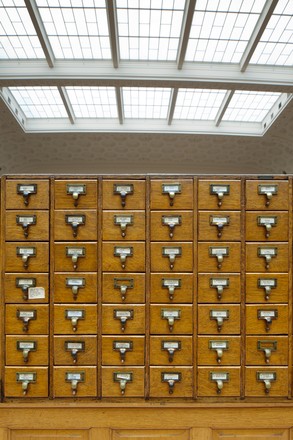The card catalogue fills the wooden cabinets that run through the centre of the Mitchell Reading Room. The drawers contain thousands of handwritten cards listing the bibliographic details of the books, maps, pamphlets, magazines, news cuttings, scrapbooks, playbills, theatre programs, menus and sheet music in the Mitchell Library.
Before electronic digital catalogues, card catalogues were used to locate specific material on the shelves in a library. The State Library moved to an electronic catalogue digital archiving system in 1980, and as a result, additions to the card catalogue stopped.
The cards are filed alphabetically by author or subject, and where possible list the date, title, publisher and description. Each of these cards carries a special number based on the Dewey decimal classification system, which was developed by American Melvil Dewey in 1876. The Dewey system classifies all books by subject, and places like subjects together on the shelf.
Through those swinging doors
… Waiting for some boxes the other day … it struck me. I’ve been using the Mitchell intermittently for nearly half its life. Someone brought me to the reading room of the Public Library in the fifties when I was still at school and I was bowled over by the faint green light from the ceiling and, the vertigo stairs and the peculiar smell of linoleum. I was at university before I took a right turn at the map of the world and walked through those swinging doors into the crowded, serious, forbidding space of the Mitchell. Two things survive forty years later: the impossible card catalogues and the stern tenderness of the staff.
Journalist and author David Marr, 2010
Footnotes
One hundred: a tribute to the Mitchell Library, 2010, p 43
Moving into the digital age
Over five years from July 2008 to
2013, the NSW government provided $23m for the eRecords Project, which included
converting the Library’s printed catalogues to electronic records. The eRecords
project added over 1 million electronic records to the State Library’s online
catalogues. These records now provide electronic access to collections
previously only searchable via card catalogues and indexes held in the Library.



 Back to list
Back to list